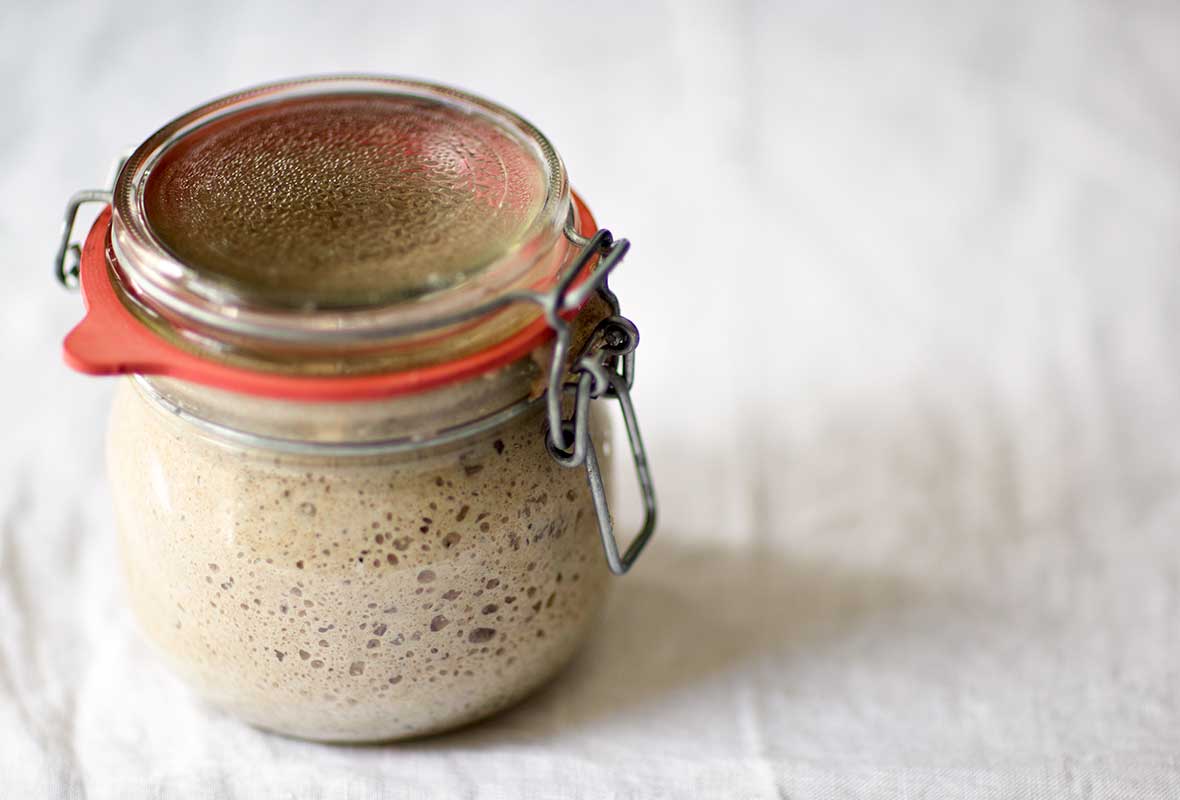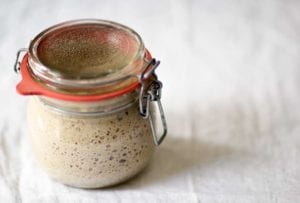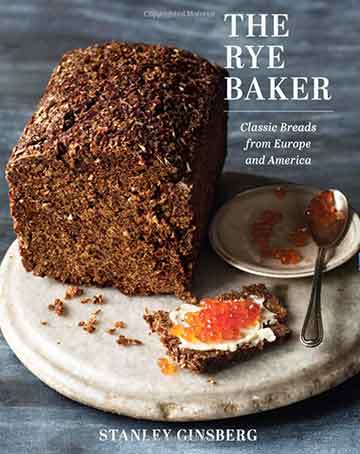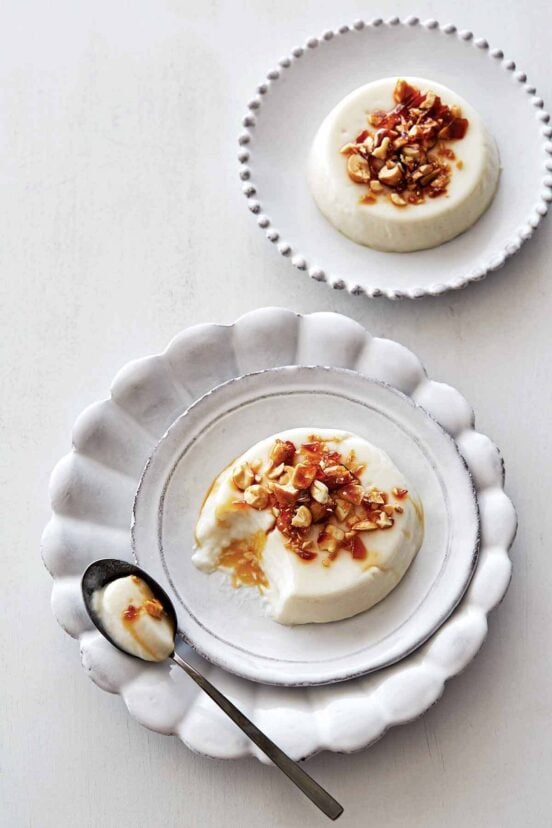
It’s not hard to make a rye sourdough starter from scratch. Some sourdough starters rely on wild yeasts that live in the air, others on acid-producing bacteria present in buttermilk, yogurt, pineapple juice, and the like, and still others start with commercial yeast or store-bought starters. Fact is, none of these additives is necessary. All it really takes to build a delicious and robust rye sour culture, or starter, is some whole-grain rye flour, water, a warm place, and patience. [Editor’s Note: And when your traditional rye sourdough starter is complete, the very first thing you’re going to want to do is use it to make this Galician rye bread.]–Stanley Ginsberg
☞ LEARN MORE, READ: HOW TO DRY SOURDOUGH STARTER

Rye Sourdough Starter
Ingredients
Day 1: Make the Rye Sourdough Starter
- 2.5 ounces whole grain rye flour, preferably organic
- 2.5 ounces warm water (105°F or 41°C)
Days 2 to 7: Refresh the Rye Sourdough Starter
- 2.5 ounces whole grain rye flour, preferably organic
- 2.5 ounces warm water (105°F or 41°C)
- 2.5 ounces Sour Starter from the preceding day
Days 8 and Beyond: Maintain the Rye Sourdough Starter
- 2.5 ounces medium or whole-grain rye flour, preferably organic
- 2.5 ounces warm water (105°F or 41°C)
- .25 ounces rye sourdough starter
Instructions
Day 1: Make the rye sourdough starter
- Start with equal amounts of organic rye flour and water by weight. Dump them in a nonreactive (glass, porcelain, stainless-steel, plastic) container, mix by hand into a stiff paste, cover, and let stand at room temperature (68 to 72°F or 20 to 22°C) for 24 hours.
☞ TESTER TIP: Occasionally the yeast normally present in whole grains fail to establish itself in a new culture; if, after 3 or 4 days, the culture darkens, develops a mold, or smells bad, dump the whole batch and start over. After a week, the culture, or sourdough starter, will be ready to use or to be stored refrigerated in an airtight container for a couple days. [Editor's Note: If storing the sourdough starter for more than a couple days, you'll need to maintain it, which we explain how to do just below.]
Days 2 to 7: Refresh the rye sourdough starter
- The next day, discard all but 2 1/2 ounces (70 grams) of the culture and mix the remainder with the refresh ingredients, cover, and let stand. Repeat each day, discarding all but 2 1/2 ounces (70 grams) of the preceding day’s culture.
☞ TESTER TIP: The most important point to remember at the early stages is to feed the sourdough starter daily. Even when it shows no apparent fermentation, the yeast is busy multiplying and consuming nutrients at a very high rate. By the second or third day, it will swell, show bubbles, and give off a clean sour smell. Over the next few days the activity will become more and more vigorous and the smell more intense.
Days 8 and Beyond: Maintain the rye sourdough starter
- In a perfect world—or in a working bakery—sourdough starters are refreshed daily. That said, daily feedings demand both a degree of dedication and abundant flour supplies that are impractical for all but the most committed home bakers. You can get by refreshing your starter every 36 hours or so.
- Mix the rye flour, water, and rye sourdough starter by hand until incorporated. Cover and ferment at room temperature (68 to 72°F or 20 to 22°C) overnight or for 10 to 12 hours. The sponge will be very bubbly, have a clean sour smell, and will have tripled in volume. Store refrigerated in an airtight container and it will last indefinitely.

Nutrition
Nutrition information is automatically calculated, so should only be used as an approximation.
Recipe Testers’ Reviews
The rye starter was easy to make and quick. It took about 5 minutes each of the 7 days. Mine smelled great and seemed consistent after the week of feedings. I switched to the refresh amounts after that and it stayed nice and healthy.
During the buildup, you end up tossing about 2/3 of it away. I definitely recommend a scale versus just using volume measurements.













This site and other sites instruct that a rye starter should have equal weights flour and water. I read somewhere else that a drier environment encourages more of the acid-forming organisms and a wetter environment more of the lactic-acid family of bacteria. Could a wetter starter work for rye? Has anyone tried it? I was thinking about this because a nearby healthfood store sells whole rye berries, and I thought that if I added more water, I could soak the berries overnight and grind them with water in a food processor the next day. This is a method I have seen recommended for making a different fermented food (dosa or idli from India, made with a grain, usually white rice, and a de-hulled legume, sometimes de-hulled lentils). Also I live in an area with heavily chlorinated water and don’t have the means to buy filtered or distilled water. Can boiling help lower the chlorine enough to give my starter a fighting chance? If so how long should I boil and do I need to wait long after that before using the water in starter? In other words could I use the water as soon as it cools or should I wait a day or two before using it?
Hi w. ally, let’s see if any readers have tried a wetter starter or experimented with rye berries. As far as your question on chlorine, many water authorities now use chloramine which is not as easily dissipated as chlorine. Perhaps using a water jug with an activated charcoal filter might help?
Ah, good idea, Thank you Beth Price. Maybe I’ll use charcoal filtering and maybe boil for good measure to help with any stray bacteria too. I’ve tried a ferment with other grains and had hit-and-miss results. Maybe lingering chloramine had something to do with it. I hadn’t heard of that, so thank you.
You are most welcome.
Hey, W. Ally! I saw your question, and I thought I’d chime in. I run the baking website The Perfect Loaf, and I get questions like yours frequently. Yes, you can definitely use more water in your rye starter, if you’d like. When I keep a rye starter, I typically do this because rye can be hard to mix each day–adding some water helps with this process.
Concerning the difference between more lactic or acetic acid: changing the hydration can affect this balance, but I’ve noticed I can achieve whatever flavor I’m after in my end bread by adjusting other parameters. For example, I can modify the percentage of whole grains in the recipe for more sourness, larger pre-ferment for more sourness, and a long, cold proof for more sourness as well. So in the end, I find it’s ok to keep your starter at whatever hydration you’d like and what makes it easy for you each day you feed/refresh.
I’m not familiar with soaking berries and then milling them, but I do mill my own flour very frequently, in fact, I currently feed my starter with 50% fresh milled (dry) hard red wheat and 50% white flour. It works extremely well. If you don’t have a mill such as a KoMo or Mockmill, you could theoretically use a high powered blender, but you won’t get near the same flour quality as a dedicated grain mill. It’s worth an experiment!
Regarding chlorine in your water supply: this is very common here in the USA. You can fill a jug of water the night before you use it for baking (or feed your starter) and leave it out on your counter uncovered. This will allow the chlorine to dissipate from the water naturally. Boiling your water is not necessary. The caveat here is if your water is treated with chloramine instead of chlorine, in this case, leaving your water out won’t help, the chloramide has to be removed in another way. In this case, I find it easier to buy distilled water.
I hope that helps!
Maurizio, thank you so much for chiming in. I knew you’d have a bounty of answers!
I cannot tell you how happy I am to have found this blog. You explain things so brilliantly.
I have been looking for a recipe for rye bread starter for weeks. However, is there a difference between rye sourdough starter and just plain rye starter? I have recipes for both.
Many thanks
There really is no difference between rye sourdough starter and rye starter. Either one is a rye starter if it uses rye flour. Most recipes will add the word “sourdough” to the name but really either one can be used to make “sourdough” or -the more accurate terminology i think since not all naturally leavened bread is sour- “naturally leavened” bread.
Many thanks for clarifying, Elie.
Ellie, thank you for your answer.
Marilee, thank you so much!
I have a rye starter bubbling away on my counter thanks to this recipe. However, this is the only recipe I’ve seen for a starter that says to feed every 36-48 hours once it’s in the fridge. Most indicate once a week for infrequent bakers and cold storage. Why feed so often by comparison for this one? And would it be resilient enough to handle resting a week in the fridge? I’ve got a vacation coming up which will mean leaving it for about that long.
Hi Lexy, I spoke with Sarah, one of our baking testers, and this is what she had to say;
“I am no way an expert bread baker, but have been working on sourdough the last year or two….the two resources I’ve drawn from (Bread Ahead Bakery in London – in person class and their cookbook, and the Sourdough School cookbook) offer varying methods on refreshing the starter. But, Bread Ahead says that once your starter is established it should be kept in the fridge and fed every 2 weeks (if you aren’t using it frequently). If/when using it, you should refresh/feed it around a day before using it for baking. If you are going to be away for more than 2 weeks, you can freeze the starter. When you come back, defrost at room temp and feed it daily until its back to its bubbly self (may take a few days). You can always freeze part of the starter as an insurance policy in case something happens to your fridge starter…would save you the time in rebuilding from scratch.
Sourdough School recommends feeding/refreshing twice a week, but also says you can leave for up to 2 weeks and then bring it back with daily feeds when you return.
The general impression I get is it is hard to kill your starter completely. It’s only no longer rescuable if, as Bread Ahead says, “it smells like dirty nappies.” :)”
Lexy, Ive had a rye starter for years. It lives in my fridge. I rarely feed it more than every other week or so. No need to waste flour every 36 hours! These things are resilient. It can go for a month (mine survived a hurricane power outage for a week too) but then it’s a good idea to feed it a couple of times dumping half out between the feedings to make sure a healthy yeast culture is back in action.
Let me know if you need more info or details of my process.
Many thanks, Elie!